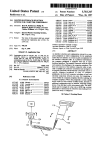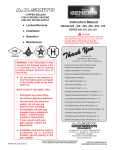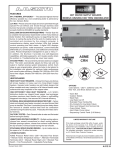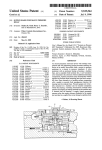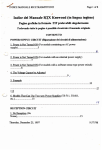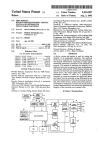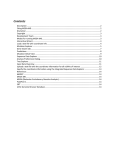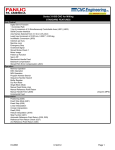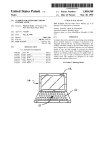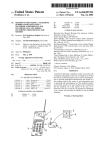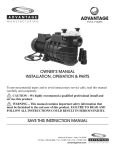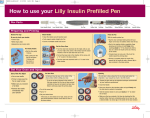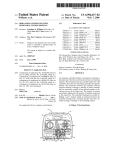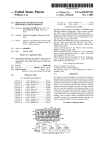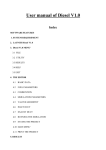Download Vial and cartridge reading device providing audio feedback for a
Transcript
‘ United States Patent 1191 Us005786584A [11] Patent Number: [45] Date of Patent: Button et al. [54] VIAL AND CARTRIDGE READING DEVICE 4,882,475 5,019,974 5,088,056 PROVIDING AUDIO FEEDBACK FOR A BLOOD GLUCOSE MONITORING SYSTEM [75] Inventors: Timothy Hemenway Button. Indianapolis; Scott Forster Percy. Carmel. both of Ind. 11/1989 111111616141. .......................... .. 235/383 5/1991 Becker's .......... .. 128/920x 2/1992 MCInlOSIl et a1. 5,091,634 2/1992 5,291,399 3/1994 ..... .. 364/569 .. 235/375 235/375 x 5,357,095 10/1994 5,371,687 12/1994 Ho1mes,Ilet a1. .. 5,401,110 5,597,995 5,663,545 [73] Assignee: Eli Lilly and Company. Indianapolis. 5,786,584 Jul. 28, 1998 . 235/3752: .... .. 364/514 3/1995 Neeley ............... .. 235/375x 1/1997 Williams et a1. .... .. 235/375 9/1997 Marquiss ............................... .. 275/375 Ind. [21] Appl. No.: 699,766 Aug. 20, 1996 [22] Filed: .............................. .. G06K 7/10 [5 1] 1111. (:1.6 .. [52] vs. c1. ........................ .. 235/462; 235/375; 235/385; 235/472; 235/486 [5 8] Primary Examiner—Donald T. Hajec Assistant Examiner—Michael G. Lee Attorney, Agent, or Firm—Michael T. Bates; David E. Boone [57] ABSTRACT A device for reading the labeled contents of an insulin Field of Search ................................... .. 235/462. 375. container and then providing an audible message informing 235/385. 435. 439. 454. 470. 472. 486; 395/28; 128/920. 921; 422/64. 65. 66. 67. 102. 104; 250/234. 566.568 the user of the labeled contents. The device includes a recessed surface. such as a cylindrical well. into which an References Cited [56] U.S. PATENT DOCUMENTS 4,164,320 4,476,381 4,622,457 4,692,308 4,729,661 4,760,245 4,831,562 8/1979 Irazoqui et a1. ...................... .. 235/375 10/1984 ' 235/375 11/1986 .. 235/464 9/1987 3/1988 7/1988 422/65 5/1989 356/437 235/379 McIntosh et a1. insulin container is insertable by a vision impaired person. An optical scanner or reader reads a code furnished as part .................... .. 564/569 of the labeling on the inserted insulin container. A micro computer compares the read code to known code patterns and a speech output is generated as to the type of insulin within the container. The speech output is broadcast over a speaker so as to be audible to a listener. The device may be integrated into a blood glucose sensor. or furnished in a unit that may assemble to an existing blood glucose sensor. 19 Claims, 15 Drawing Sheets US. Patent Jul. 28, 1998 Sheet 1 of 15 5,786,584 US. Patent Jul. 28, 1998 Sheet 4 of 15 5,786,584 0_QD< PDnE O Q5 3 31) Q a26;. G ‘.l'? l m .5 .wE wa an “HA/ml“. umc<hozmu o :5 UK M5238 i; ~_ @.wE by“ an US. Patent Jul. 28, 1998 1:81: Fig. 7 Sheet 5 of 15 5,786,584 US. Patent Jul. 28, 1998 ,55 Sheet 8 of 15 5,786,584 /? 15a - i If ; Fig. 10 152 US. Patent Jul. 28, 1993 Sheet 9 of 15 5,786,584 I60 "K "Wu. """m it US. Patent Jul. 28, 1998 Sheet 10 of 15 5,786,584 US. Patent Jul. 28, 1998 Sheet 11 of 15 5,786,584 US. Patent Jul. 28, 1998 Sheet 12 of 15 200 ' 5,786,584 / / z W Fig. 14 US. Patent Jul. 28, 1998 Sheet 13 of 15 5,786,584 US. Patent Jul. 28, 1998 Sheet 14 of 15 5,786,584 US. Patent Jul. 28, 1998 Sheet 15 of 15 5,786,584 5.786.584 2 1 Thus. it is desired to provide a device which aids the VIAL AND CARTRIDGE READING DEVICE PROVIDING AUDIO FEEDBACK FOR A BLOOD GLUCOSE MONITORING SYSTEM vision impaired patient in choosing the correct insulin container for insulin injection. SUMMARY OF THE INVENTION CROSS REFERENCE TO RELATED APPLICATION This application claims the bene?t under 35 U.S.C. § 119(e) of United States Provisional Application Ser. No. 60/003328. ?led Sep. 6. 1995. BACKGROUND OF THE INVENTION The present invention pertains to blood glucose sensors or monitors for analyzing a blood droplet and outputting to the user a blood glucose reading. and. in particular. to a blood glucose sensor having an audio feedback. Blood glucose sensors are well known in the art. Recently. sensors have been developed to include audio output to aid The present invention provides a voice synthesizer device allowing a visually impaired person or diabetic to indepen dently determine the contents of insulin containers. The device ?rst identi?es the labeled contents of an insulin container. and then generates an audible message to inform 10 the user of the contents. The insulin container includes a readable code. such as a bar code. on its label. When the bar code is read by an optical scanner in the device. a voice synthesizer coupled to a speaker in the device produces an audible message to a user as to the contents of the insulin container. The device may be integrated into a blood glucose sensor. or provided in a unit that assembles to an existing blood glucose sensor. In one form thereof. the present invention provides a patients in monitoring their own glucose levels despite their vision loss. Such sensors have been called talking glucom eters. One leading sensor is commercially available from Boehringer Mannheim Diagnostics. Inc.. Indianapolis. Ind.. device for identifying a labeled content of a medication 20 modate a container containing a medication. a reader arranged to read a medication identifying code on the under the trade name Accu-Chek® 11 Freedom System. In this device. a user deposits a drop of blood onto a test strip pad with the aid of a ?nger guide. The device optically senses the blood and outputs the audio instruction “Press the timer button." After the timer button has been pushed. a 25 visual and audio blood glucose reading is communicated to the patient. The entire system is housed in a single unit. Another audio blood glucose monitoring system is commer an audible message to a user of the device. N.J.. under the trade name Diascan Partner. Like the Accu In another form thereof. the present invention provides an Chek® II. this system is housed in a single unit and includes insulin label reading device including a body. which is either a voice module for providing messages on calibration and con?gured as an adaptor into which a separate portable blood glucose sensor removably inserts or con?gured as a glucose readings. 35 their own natural glucose curves over the course of a day. For example. Lilly produces Humulin® R. Humulin® N. Humulin® L. Humulin® U. Humulin® 50/50. and Humu lin® 70/30. A container of Lilly insulin typically includes a 40 housing into which a portable blood glucose sensor is integrated. means. within the body. for reading an insulin identifying code on an insulin container. and means. cir cuited to the code reading means. for providing an audible message to a user identifying a type of insulin labeled by the code as within the container. In still another form thereof. the present invention pro~ bar code on its label known as the “pharma code". This bar code is part of one type of internal security check which may be used in the manufacturing process to ensure that a speci?c label matches the contents of the container on which the container when the container is positioned at the body portion. a controller within the body and circuited to the reader to receive a signal from the reader corresponding to the read code. wherein the controller compares the signal to stored data. a voice synthesizer for generating a speech pattern identifying the medication in the container respon sive to the controller comparing the signal and stored data. and a speaker for broadcasting the speech pattern to provide cially available from Home Diagnostics. Inc.. Eatontown. Eli Lilly and Company (“Lilly”). a world leader in the production of insulin products. produces a number of dif ferent types of insulin to enable patients to better simulate container including a body with a portion shaped to accom vides the combination of a medication container which includes a code arranged on a portion of an exterior con tainer surface. and a device for identifying a labeled content 45 of the medication container. The device includes a body label is a?ixed. Prior to the label being applied to a given container. the manufacturer scans the bar code to verify that including a portion complementarily shaped to the medica an appropriate labeling is occurring. Each of the Lilly insulin products is designed for a particular glucose level and for a particular duration. Often. container when the container is positioned at the portion. a controller within the body and circuited to the code reader to receive a signal from the code reader corresponding to the read code. wherein the controller compares the signal to stored data. a voice synthesizer for generating a speech pattern identifying the medication in the container respon sive to the controller comparing the signal and stored data. tion container. a code reader arranged to read the code on the a patient will inject himself/herself with one insulin product in the morning and a dilferent insulin product in the after noon and/0r evening. Serious adverse medical consequences could occur if a patient mistakenly grabs the wrong insulin container and injects himself/herself with the wrong insulin product (e.g. Humulin® R instead of Humulin® U). Accordingly. it is important that the patient choose the 55 One advantage of the present invention is that an audible correct insulin container for use at a given time. message as to the labeled contents of a medication containm The selection of the correct insulin container is generally is provided. not a problem for those individuals having good eyesight Another advantage of the present invention is that its user-friendly design allows its use by a person with impaired and who can easily read the label on the container. However. for those individuals with limited or no vision. a greater risk vision to independently determine the labeled contents of a medication container. exists that a misreading or a failure to read the label on the container will occur. which in turn may result in an inad vertent selection of a wrong container. Because impaired vision is often a result of diabetes. this problem can be signi?cant. and a speaker for broadcasting the speech pattern to provide an audible message to a user of the device. 65 BRIEF DESCRIPTION OF THE DRAWINGS The above mentioned and other advantages and objects of this invention. and the manner of attaining them. will 5,786,584 3 4 become more apparent and the invention itself will be bettq this system embodiment. base unit 30 serves as a voice understood by reference to the following description of synthesizer adaptor which furnishes an existing sensor prod embodiments of the invention taken in conjunction with the uct with the inventive features of first identifying the labeled accompanying drawings. wherein: contents of an insulin container and then broadcasting an audible message to a user as to the identity of the contents. FIG. 1 is a perspective view of a ?rst embodiment of the present invention in which a blood glucose monitor is removably housed within a base unit including a vial and The con?guration of sensor 27 shown in FIG. I and in the additional embodiments conforms to the Accu-Chek® AdvantageTM blood glucose monitor. which is commercially available from Boehringer Mannheim Corporation of 1nd. cartridge reader of the present invention; FIG. 2 is a plan view of the embodiment of FIG. 1 with the monitor shown removed. and wherein selected internal Indiana. Except as further explained below. additional detail regarding the AdvantageTM type monitor and the associated components contributing to the container reading and audio test strips are not necessary for an understanding of the present invention. and therefore are omitted herein. Such detail can be found in the User's Manual for the Advan tageTM type monitor and US. Pat. Nos. 4.963.814. 4.999. output functions are diagrammatically shown in dashed lines; FIG. 3 is a diagrammatic side view of the embodiment of FIG. 1. wherein select portions of the invention are shown 582. 4.999.632. and 5.243.516. which are all incorporated in dashed lines; FIG. 4 is a diagrammatic front view illustrating the placement of bar codes on different types of insulin con tainers; FIG. 5 is a front view of an example of a bar code for a container label; herein by reference. It will be appreciated that with appropriate modi?cation. base unit 30 can be adapted to function with other types of 20 Alternatively. rather than being provided within an acces sory or separate component which retro?ts existing monitors FIG. 6 is a general block diagram of the code scanning and audio output functions of the present invention; FIG. 7 is a plan view of a second embodiment of a blood glucose monitoring system of the present invention; 25 FIG. 8 is a plan view of a third embodiment of a blood glucose monitoring system of the present invention; FIG. 9 is a diagrammatic side view of the system of FIG. 8. wherein some of the internal components and inserted containers are diagrammatically shown in dashed lines; FIG. 10 is a front perspective view of a fourth embodi Blood glucose monitoring system 25 will be further invention; 35 of a blood glucose monitoring system of the present inven FIG. 13 is a front perspective view of a sixth embodiment the outlines of two different types of insulin containers shown in dashed lines inserted within base unit 30 in bar of a blood glucose monitoring system of the present inven tion; code scannable arrangements. Base unit 30 includes a main housing or body 32 made of a washable. durable plastic material which may be formed in FIG. 14 is a front perspective view of a seventh embodi ment of a blood glucose monitoring system of the present FIG. 15 is a front perspective view of an eighth embodi base unit 30 for purposes of illustration. and wherein selected components of the internal workings of base unit 30 are diagrarmnatically shown in dashed lines. FIG. 3 is a diagrammatic side view of system 25 from FIG. 1 with selected components again shown in dashed lines. and with tion; invention; as shown. the inventive features may be integrated into the housing and internal circuitry or workings of a blood glu cose monitor product. including one having other audio or visual feedback designs. within the scope of the invention. Moreover. the explanation herein with reference to a blood glucose monitoring system is illustrative and not limiting. as the inventive features may ?nd bene?cial application in identifying other types of medications within containers. described with additional reference to FIGS. 2 and 3. FIG. 2 is a plan view of system 25 with monitor 27 removed from ment of a blood glucose monitoring system of the present FIG. 11 is a top view of the system of FIG. 10; FIG. 12 is a front perspective view of a ?fth embodiment existing blood glucose monitors. 45 the shown shape from mating or secured together parts. Rubber stando?’s (not shown) on the base unit bottom ment of a blood glucose monitoring system of the [resent surface provide stability during use. Two forwardly extend ing ?anges 35 of body 32 each have an interior surface invention; FIG. 16 is a rear perspective view of the system of FIG. contoured to the sides of monitor 27 and serve to retain 15; and FIG. 17 is a front perspective view illustrating another monitor 27 on body platform 37. A guide member 39 is detachably mounted to the forward end of body 32. As embodiment of a system of the present invention. shown in FIG. 3. the upper portion of guide member 39 projects above the height of platform 37 and prevents Corresponding reference characters indicate correspond ing parts throughout the several views. Although the draw ings represent multiple embodiments of the invention. the drawings are not necessarily to scale and certain features may be exaggerated or omitted in selected drawings in order to better illustrate and explain the present invention. DESCRIPTION OF THE PRE'ERRED EMBODIMENTS Referring now to FIG. 1. there is shown a front perspec tive view of a ?rst embodiment of a blood glucose moni toring system of the present invention. The system. which is generally designated 25. includes a blood glucose sensor or monitor 27 with a visual display 29 mounted within a separate housing or base unit. generally indicated at 30. In monitor 27 from sliding out from an installed or inserted 55 position between ?anges 35. Guide member 39 provides tactile guidance to aid a vision impaired user in properly inserting and then dosing a test strip by feel. Guide member 39 includes a channel 40 sized and con?gured to guide a test strip 26 (see FIG. 3) during its insertion into blood sample insert port 28 of monitor 27. When test strip 26 is properly inserted into port 28. ridges 42 align with an opening in the test strip whereat a droplet of blood is to be applied Guide member 39 may be removably attached to body 32 in a variety of ways. For example. guide 65 member 39 may include a downwardly opening hollow. de?ned by a keyed interior surface. which ?ts over a cornplementarily designed lip forwardly projecting from 5.786.584 5 6 body 32. Guide member 39 and the projecting body lip may channels contains one bar that is two bits wide and the be provided with mating latching elements. such as a rod and a cooperating bore. to secure guide member 39 to body 32 to limit occasions of inadvertent disassembly. Other guide member shapes may be provided in addition to the alternate con?gurations shown herein. For example. the guide mem ber could de?ne a cavity into which the tip of a user's ?nger vertical alignment of these channels relative to the data ?ts during application of the blood droplet. particular pattern. namely 0101. appears on the white back Along its top surface. body 32 includes a recessed surface. generally designated 44. into which insulin containers may be separately introduced for a reading of their labeling. As channels is such that one edge of a bar from one of the channels is aligned with the middle of the bar in the data channel. The output of the quadrature channels produces a gray code that changes at the center of the data bits. For a ten milliliter vial. FIG. 5 is an example of how a 10 ground of the vial. The bar code includes at least four bits in the top two channels. and is at least approximately 0.160 inch wide (four bits at 0.040 inch per bit). The bar channel better shown in FIGS. 2 and 3. recessed surface 44 de?nes a ?rst cylindrical concavity 46 and a second cylindrical height is at least approximately 0.74 inch (four channels at 0.185 inch per channel). The minimum position of the bar concavity 48. Concavity 48 opens into concavity 46 and extends deeper into body 32 than concavity 46. Concavities code is approximately 0.230 inch from the bottom of the ten milliliter vial. 46. 48 are shown as well- shaped cavities or “wells" particularly sized and shaped to accommodate speci?c types Referring again to FIGS. 2 and 3. connector plug 55 including circuit pins is cantilevered above base platform of insulin containers. 37. Plug 55 is circuited to the internal electronic circuitry or Insulin is conventionally available to users in two differ ent types of containers. One type is a vial that usually microcomputer of base unit 30 via a connector indicated at 57. This microcomputer or internal circuitry. which controls contains ten milliliters of liquid insulin. A single-use syringe the operations of base unit 30. is generally referenced as 59 and is abstractly shown in the form of a printed circuit board for purposes of illustration. but may be alternatively con ?gured within the scope of the present invention. When monitor 27 is mounted to base unit 30. plug 55 inserts into a code key slot or compartment Within the back of monitor 27 to provide an electrical interface between the microcir cuitry of monitor 27 and base unit 30. In an AdvantageTM type monitor such as 27. the code key slot normally receives a code key or chip included with each container of test strips purchased by the user. The code key calibrates the monitor for use with a particular set of test strips. In the embodiment of FIG. 1. such a code key is shown at 61 operationally installed in a ROM key port 63 within body 32 that is includes a needle that pierces the rubber stopper at the top of the vial to draw up the desired amount of insulin. Another type of container is a cartridge. primarily designed for use with multiple dose syringes. 25 Cartridges for insulin are often available in two sizes. namely three milliliters and one and one-half milliliters. Both vials and cartridges are conventionally made of glass. Cylindrical concavity 48 has a diameter sized to insert 30 ably receive the cylindrical end of a three milliliter insulin cartridge shown in dashed lines at 50. Cylindrical concavity 46 is sized to receive the bottom cylindrical end of a ten milliliter insulin vial shown in dashed lines at 51. Base unit 30 naturally may be designed to only accommodate one type of container. such as vials which have a larger circumference upon which coding may be more readily positioned. Accord ing to the present invention. the label which is a?ixed to each insulin container is provided with a readable code that is used in identifying the contents of the insulin container. As abstractly shown in FIG. 4. which is a front view showing the outlines of cartridge 50 and vial 51 as relatively posi tioned when fully inserted into their respective concave 35 circuited with internal circuitry 59. Code key 61 is manually. slidably insertable into port 63 and removable therefrom through an opening (not shown) in the rear and bottom surface of body 32 that is con?gured similar to the corre sponding housing opening of the AdvantageTM type monitor. Insulin bar code reader or scanner 6 is positioned at a height within recessed surface 44 at which bar code 53 will be located when either container 51 or 50 is fully inserted into its respective well. Bottom or stop surfaces 47 and 49. wells 48. 46. a bar code 53 is located on the cylindrical periphery of each of the containers at a height indicated in 45 which abut the inserted container ends. are arranged at a dashed lines. Bar code 53 will normally be a preprinted part of the overall label artwork and be in addition to the pharma code. Bar code 53 may alternatively be separate from the overall label and separately af?xed or otherwise incorpo rated into the container. For di?‘erent containers. bar codes 53 are positioned at di?‘erent heights from the container bottoms in conjunction with the different well depths. As shown in FIG. 4. this positioning technique allows the bar longitudinal distance from scanner 66 equal to the distance between the bar code and container bottom such that this bar code positioning is achieved. Scanner 66 faces radially inward and ports through recessed surface 44 so as to open into the container wells to read bar code 53. Scanner 66 is circuited with internal circuitry 59 by a connector 68 through which electrical power and signals are communi cated. A suitable scanner or bar code reader 66 is an optical codes of both vials and cartridges to be read by a common reader or scanner. which is indicated at 66 and described 55 sensor employing IR LEDs and sensors adapted to read the further below. The type of code used for bar code 53 may be selected by one of ordinary skill in the art. A suitable bar code for use with a four-channel bi-directional bar code reader includes black bars on a white background. The black bars are up to 90% less re?ective than the white backdrop. The bar code is bi-directional in that it is readable for either direction of black on white bar code. Other types of cooperating codes/ readers may alternatively be employed. As used herein. the term codes encompasses more than merely written or printed indicia such as those having no apparent meaning to the untrained eye. and includes comprehensible markings as well as elements that mechanically or otherwise engage a complementarily structured “reader” to furnish input as to the particular container contents. containm' rotation as described below. The top channel of the Internal circuitry 59 includes a speech controller or voice bar code contains four bits of information identifying the type of insulin. The second channel is the inverse of the top 65 synthesizer circuitry. which may be supplied as an integrated computer chip connected to a circuit board. Speaker 72 is channel and is vertically aligned with the top channel. The circuited to voice synthesizer 59 with not shown conductors lower two channels are quadrature channels. Each of these 5.786.584 7 8 and broadcasts the speech pattern output by voice synthe patterns. each of which corresponds to a different one of sizer 59 to convey an audible message to a user. Not shown Lilly’s insulin products. may be stored. These reference patterns will typically be stored in and retrieved from code key 61. but may alternatively be stored in and accessed from apertures provided through the portion of the bottom panel of base unit body 32 covering speaker 72 facilitate sound transmission. 5 A power supply for base unit 30 is supplied independent of the normal battmy for monitor 27. A battery 74. such as a nine volt alkaline battery. ?ts within an internal compart ment provided in body 32 and is electrically connected to circuitry 59 with not shown conductors to provide suitable electrical energy to base unit 30. Rather than using battery power. base unit 30 may be plugged into an AC current source through the use of a jack (not shown) provided on 72. which broadcasts the signal as an audio message or 10 speech output signal 82 causes the message broadcast by The overall structure and operation of blood glucose monitoring system 25 will be further understood in view of the following explanation of its utilization. Base unit 30 may be operated to identify container contents when monitor 27 speaker 72 to be that a valid bar code was not found and that the insulin vial should be re-inserted. If a user misses the is not provided. or when monitor 27 is installed and used for the degree of rotatcon of dial 76 from its off position as is conventional. If monitor 27 is installed as shown in FIG. 1. turning on base unit 30 automatically turns on monitor 27. 20 25 The microcomputer with voice synthesizer 59 and speaker 72 may be programmed to cooperate with monitor 27 to 30 all available AdvantageTM type monitor function indicators. error messages. control results. test results. and memory results with corresponding date and time may be broadcast. To utilize the insulin container contents identifying 35 feature. a user inserts an insulin container into either well 46 Referring now to FIG. 7. there is shown a plan view of a 66. To facilitate explanation. the following explanation will assume a labeled vial is the insulin container to be read. In some circumstances. the insenion into well 46 may be in response to an audible. instructional prompt of “insert vial" 45 typically be unable to assure a proper alignment of bar code 53 with scanner 66. the invention is designed such that the rotational orientation of insulin vial S1 at the time of its After the vial insertion is sensed. such as by an additional microswitch (not shown) at the base of well 46. the voice synthesizer of inta'nal circuitry 59 then generates a speech output which is broadcast through speaker 72 as “rotate a button to change the language of the outputted message. for example from English to Spanish. In addition to the insulin type. the bar code 53 and overall programming and memory of base unit 30 could be modi?ed to audibly communicate additional information. such as the insulin expiration date. A headphone jack. as well as an automatic turn-01f feature after passage of a ?nite period of system inactivity. may also be furnished. In conjunction with bar ality of reader 66. properly inserting by feel the container to be read by scanner insertion does not compromise the operation of the system. In addition to the numerous system features shown and described with reference to the embodiment of FIG. 1. additional features may be provided to system 25 within the scope of the present invention. For example. base unit 30 may be provided with a button which accesses the memory of monitor 27. and which can be used to program the monitor. Base unit 30 may include a button to change the code reader 66. a calibration device may be provided with a ?xed predetermined bar code for use to insure the function or 48 as appropriate. It will be recognized that the well shaped recess guides even the most visually impaired user in broadcast by speaker 72 in response to a command by microcomputer 59. Because a sight impaired user will message broadcast through speaker 72. repeat button 86 (See FIG. 1) may be pressed to automatically replay the last message broadcast through speaker 72. gender of the voice announcing the outputted messages. and supply speech output appropriate for the normal operations of monitor 27. For example. prompts suitable to help a vision impaired user perform a blood glucose test with monitor 27 and test strip 26 may be broadcast. In addition. output 84 to be heard by the user. If inputted signal 80 was matched to one of the recognized. stored patterns. speech output signal 82 causes speaker 72 to broadcast an audible message which informs the user as to the type of insulin which the label claims to be in vial 51. If no match is found. body 32. its blood glucose testing capabilities. Base unit 30 is turned on by manually rotating combination ondial 76 shown in FIG. 1. The volume level of speaker 72 can be controlled by a memory module or circuit provided in internal circuitry 59. After the inputted signal 80 is compared to the known patterns. the voice synthesizer within microcomputer 59 produces a speech output signal 82 transmitted to speaker second embodiment of a blood glucose monitoring system 90 of the present invention. System 90 and the additional embodiments shown and described below are conceptually similar in numerous respects to the embodiment of FIG. 1. and each of these embodiments includes the label reading and audible label identifying features described in greater detail above with reference to system 25. Therefore. further description of these alternate embodiments primarily focuses on differences between the systems and additional 50 detail pertinent to a further understanding of system 25. As shown in dashed lines in FIG. 7. system 90 includes an L-shaped printed circuit board 94. with the notch forming the “If providing space within housing or body 92 for battery 97. An AdvantageTM type blood glucose monitor 96 is laterally off-set along the top surface of body 92 and held within the base unit by ?anking ?anges 98 and guide vial". In response to this prompt. a user rotates or spins vial 55 51 to effect bar code reading. The user may rotate vial 51 within well 46 in either direction and still obtain a proper member 100. As with the embodiment of FIG. 1. insulin insulin identi?cation due to the bi-directional aspect of bar vials and cartridges are insertably received within well code 53. shaped receptacles 102 and 103. respectively. such that the insulin container bar codes can be scanned by reader 105 With additional reference to the schematic of FIG. 6. during container rotation. during vial rotation. scanner 66 reads bar code 53 in a Referring now to FIGS. 8 and 9. a third embodiment of a process represented at 78. Responsive to its reading bar code blood glucose monitoring system 110 of the present inven 53. scanner 66 then outputs a signal at 80 corresponding to tion is illustrated. FIG. 8 is a top view of system 110. FIG. the read code. Signal 80 is transmitted through connector 68 and reaches microcomputer 59. which compares inputted signal 80 to a number of separate. stored patterns associated with various types of insulin. For example. sixteen unique 9 is a diagrammatic side view of system 110. wherein selected internal components of the system are diagrammati cally shown in dashed lines and wherein a vial and cartridge






















